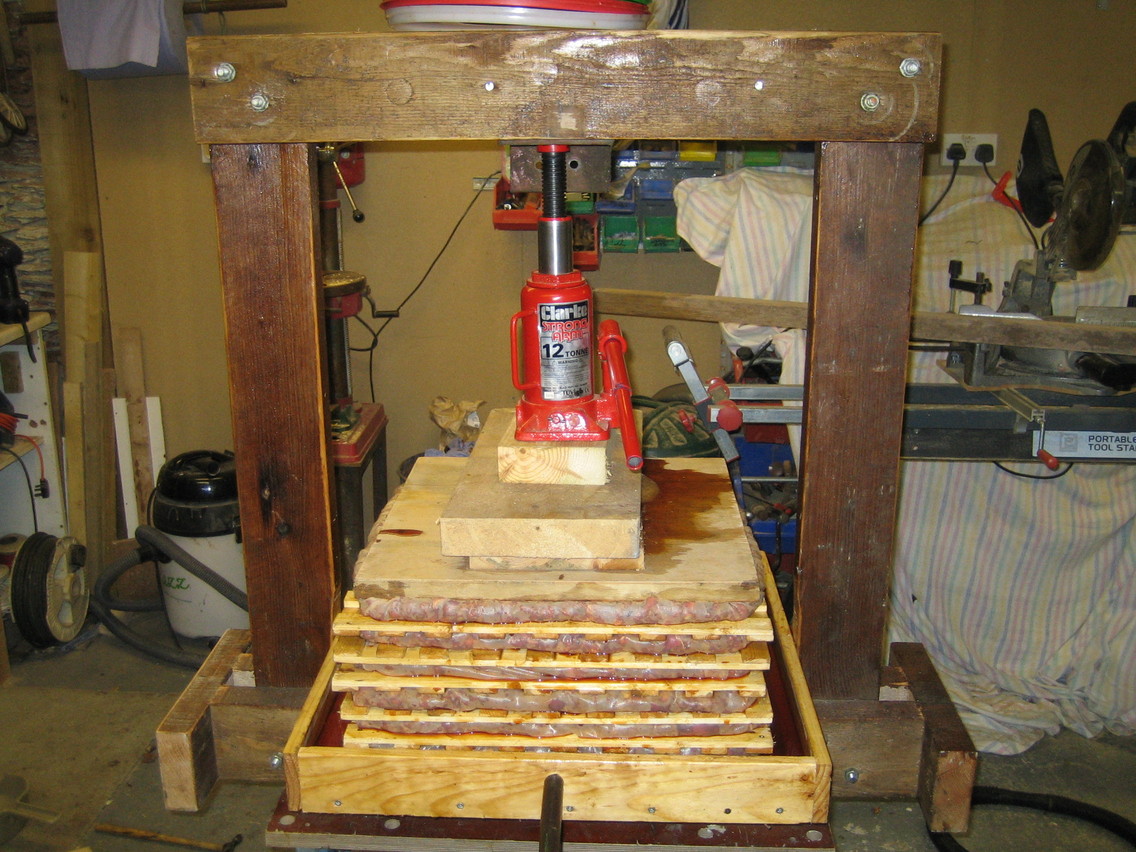Complete luck John, the MLF was spontaneous but as I fermented in my cellar the bugs down there are myriad. I was cautious in my addition of tannin (stewed tea) and my addition of lactose to balance some of the acidity (pH of original must was on the low limit). The clarity is verging on a commercial standard so everything else I tried to achieve worked. Next time I'm hopeful about making a pretty good one.jmc wrote:
Sounds good orlando.
Did you get a spontaneous MLF or did you add some lactobacillus?
I ended up making about 5 batches of 5-6gal.
1st one was drunk on and after Christmas and 2nd one nearly gone. Both of these dropped bright.
What I really like is difference between each batch as they use different apples I found/blagged in Sept-Oct last year.
2nd batch definitely smoother than 1st but both dry.
Luckily I like dry
Apples...
- orlando
- So far gone I'm on the way back again!
- Posts: 7201
- Joined: Thu Nov 17, 2011 3:22 pm
- Location: North Norfolk: Nearest breweries All Day Brewery, Salle. Panther, Reepham. Yetman's, Holt
Re: Apples...
I am "The Little Red Brooster"
Fermenting:
Conditioning:
Drinking: Southwold Again,
Up Next: John Barleycorn (Barley Wine)
Planning: Winter drinking Beer
Fermenting:
Conditioning:
Drinking: Southwold Again,
Up Next: John Barleycorn (Barley Wine)
Planning: Winter drinking Beer
- jmc
- Even further under the Table
- Posts: 2486
- Joined: Thu May 13, 2010 11:43 pm
- Location: Swaledale, North Yorkshire
Re: Apples...
How much lactose did you add to the juice? I'm thinking of adding some to some of it when bottling for friends that don't like it quite so dry.orlando wrote:Complete luck John, the MLF was spontaneous but as I fermented in my cellar the bugs down there are myriad. I was cautious in my addition of tannin (stewed tea) and my addition of lactose to balance some of the acidity (pH of original must was on the low limit). The clarity is verging on a commercial standard so everything else I tried to achieve worked. Next time I'm hopeful about making a pretty good one.jmc wrote:
Sounds good orlando.
Did you get a spontaneous MLF or did you add some lactobacillus?
I ended up making about 5 batches of 5-6gal.
1st one was drunk on and after Christmas and 2nd one nearly gone. Both of these dropped bright.
What I really like is difference between each batch as they use different apples I found/blagged in Sept-Oct last year.
2nd batch definitely smoother than 1st but both dry.
Luckily I like dry
Did your lactose addition make much difference?
I've found that my palate has changed since making my own TC and real cider.
Most commercial 'medium' cider now tastes very sweet and even some 'medium-dry' ones are a bit sweet.
Cheers John
- orlando
- So far gone I'm on the way back again!
- Posts: 7201
- Joined: Thu Nov 17, 2011 3:22 pm
- Location: North Norfolk: Nearest breweries All Day Brewery, Salle. Panther, Reepham. Yetman's, Holt
Re: Apples...
Can't remember quantities but I simply kept adding lactose to a measured sample until I thought it was about right and multiplied it up. I have to say I was a little too cautious so it is a little too acidic for my taste, but yes it did make a difference. Commercial Cider is horrible, I tried the bollocks Stella put out and I was hard pressed (forgive the pun) to taste apple at all and as for their Pear version it was a complete travesty. The sooner this synthetic nonsense is found out and rejected the better. Unfortunately it is aimed at the alco pop market whose image has taken a bashing with the old rubbish so they now have to try this new rubbish, sweet stuff suits that market and their bottom line.jmc wrote:How much lactose did you add to the juice? I'm thinking of adding some to some of it when bottling for friends that don't like it quite so dry.orlando wrote:Complete luck John, the MLF was spontaneous but as I fermented in my cellar the bugs down there are myriad. I was cautious in my addition of tannin (stewed tea) and my addition of lactose to balance some of the acidity (pH of original must was on the low limit). The clarity is verging on a commercial standard so everything else I tried to achieve worked. Next time I'm hopeful about making a pretty good one.jmc wrote:
Sounds good orlando.
Did you get a spontaneous MLF or did you add some lactobacillus?
I ended up making about 5 batches of 5-6gal.
1st one was drunk on and after Christmas and 2nd one nearly gone. Both of these dropped bright.
What I really like is difference between each batch as they use different apples I found/blagged in Sept-Oct last year.
2nd batch definitely smoother than 1st but both dry.
Luckily I like dry
Did your lactose addition make much difference?
I've found that my palate has changed since making my own TC and real cider.
Most commercial 'medium' cider now tastes very sweet and even some 'medium-dry' ones are a bit sweet.
Cheers John
I am "The Little Red Brooster"
Fermenting:
Conditioning:
Drinking: Southwold Again,
Up Next: John Barleycorn (Barley Wine)
Planning: Winter drinking Beer
Fermenting:
Conditioning:
Drinking: Southwold Again,
Up Next: John Barleycorn (Barley Wine)
Planning: Winter drinking Beer
Re: Apples...
Been reading this thread with interest.
I have a bunch of cider apple trees from which I've never yet been able to make cider I found acceptable. Partly I think that's because I had no idea what variety they were. I've now come to the conclusion that I have some Dabinett, some Somerset and some Yarlington Mill, along with a few others I can't identify. The Somersets are horrible. They fruit in abundance, but make utterly bland cider. The Dabinetts should make decent single-variety cider if I can get enough of them, but they aren't that prolific. My plan at some point is to crown-graft the Somersets over to Dabinett. Over the last few years I've also planted some other varieties to give a wider range to work with, including Tom Putt, Kingston Black, Tremlett's Bitter and Sweet Alford. I may well graft some of the other unknown trees over to these too.
I have a press I bodged up myself powered by a 12-tonne bottle jack:

That used to bow a bit, so I made a new frame from 6x2:

Regarding the colour of the cider, proper cider apples are often much, much higher in tannin than eaters and cookers. Whereas you can crush the latter and the flesh will stay a pale creamy colour for quite some time, the tannin levels in cider apples will cause them to go brown within minutes, literally. It's nigh on impossible to crush them and get them in the press and get the juice into the fermenter without it taking on quite a brown colour and that transfers to the final product.
I like the idea of using the HLT for pasteurising straight juice. That definitely appeals to me. I'll have to look into that come the autumn.
James
I have a bunch of cider apple trees from which I've never yet been able to make cider I found acceptable. Partly I think that's because I had no idea what variety they were. I've now come to the conclusion that I have some Dabinett, some Somerset and some Yarlington Mill, along with a few others I can't identify. The Somersets are horrible. They fruit in abundance, but make utterly bland cider. The Dabinetts should make decent single-variety cider if I can get enough of them, but they aren't that prolific. My plan at some point is to crown-graft the Somersets over to Dabinett. Over the last few years I've also planted some other varieties to give a wider range to work with, including Tom Putt, Kingston Black, Tremlett's Bitter and Sweet Alford. I may well graft some of the other unknown trees over to these too.
I have a press I bodged up myself powered by a 12-tonne bottle jack:

That used to bow a bit, so I made a new frame from 6x2:

Regarding the colour of the cider, proper cider apples are often much, much higher in tannin than eaters and cookers. Whereas you can crush the latter and the flesh will stay a pale creamy colour for quite some time, the tannin levels in cider apples will cause them to go brown within minutes, literally. It's nigh on impossible to crush them and get them in the press and get the juice into the fermenter without it taking on quite a brown colour and that transfers to the final product.
I like the idea of using the HLT for pasteurising straight juice. That definitely appeals to me. I'll have to look into that come the autumn.
James

